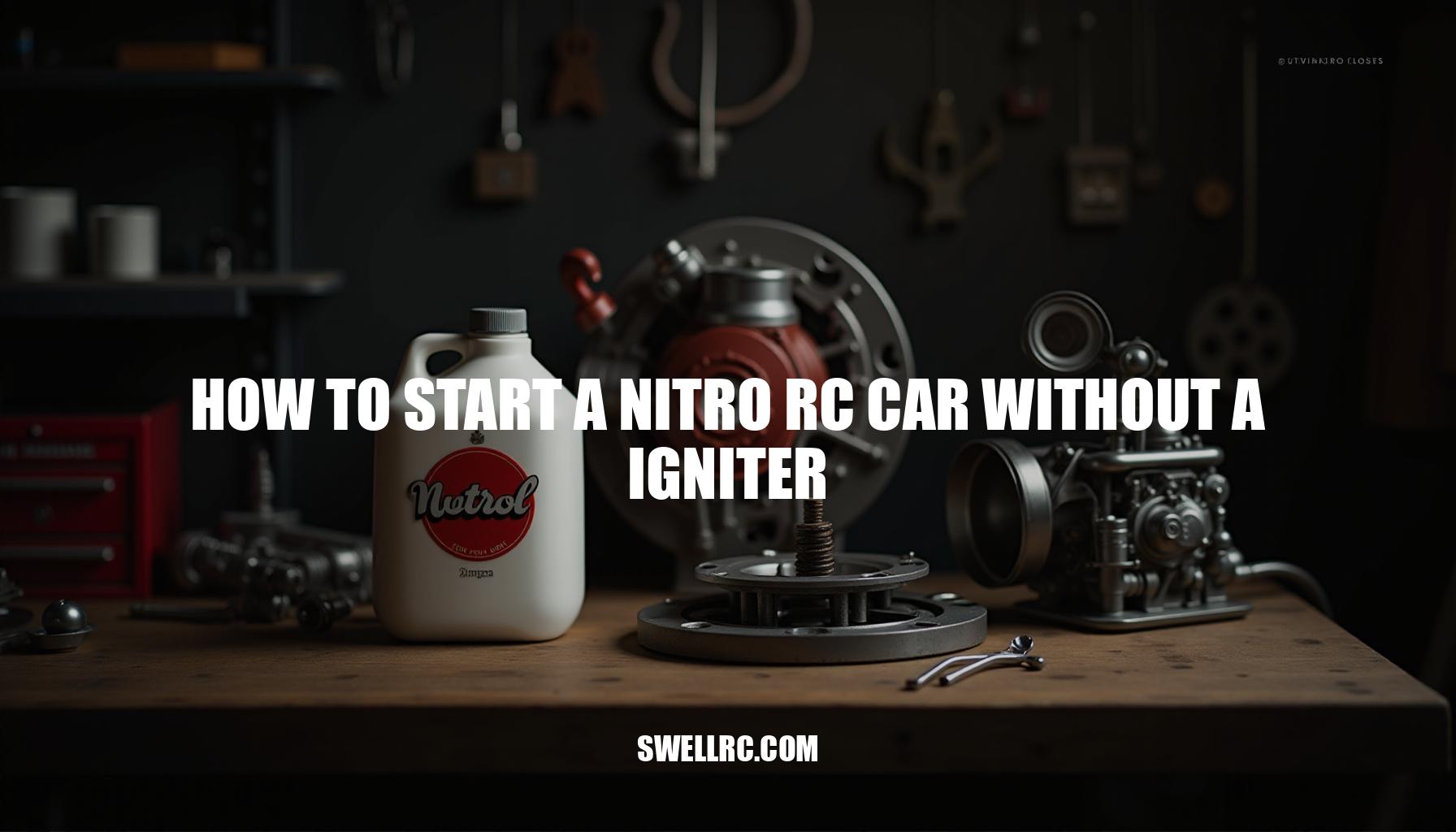How to Start a Nitro RC Car Without an Igniter
I still remember the first cold morning I forgot my glow starter at home. The track was perfect, my fuel was fresh, and my thumbs were itching—yet my nitro RC car’s engine wouldn’t even cough. That little setback kicked off a personal mission to figure out exactly how to start a nitro engine without a glow igniter, safely and reliably.
After a weekend of experimenting with various glow igniter alternatives, a couple of burned fingers (my mistake), and a lot of trial-and-error, I came away with practical methods that actually work in the real world. In this guide, I’ll show you the tools and workarounds I tested, how to prep and tune your nitro RC cars for easier starts, and the essential troubleshooting steps that saved me when the engine still refused to light. Whether you’re using an RC starter or starting a nitro RC car manually, these safety tips and techniques will ensure a missing igniter never sidelines your fun again.
Let’s dive in and make sure you’re fully prepared on your next outing.
Understanding How Nitro RC Engines Actually Work
A nitro engine, commonly found in radio control nitro cars, is a tiny heat engine that operates using nitro fuel, a methanol-based mixture combined with nitromethane and oil. In essence, the fuel and air mixture is regulated by the carburetor settings, ensuring the correct balance for efficient combustion. Air and fuel blend in the carburetor before entering the combustion chamber, where ignition occurs due to the heat generated by the glow plug.
The glow plug role is critical in the starting sequence: its coil heats up initially via an external power source, triggering the first combustion events. Once running, an exothermic reaction between the methanol and the platinum in the glow plug sustains the coil’s temperature, maintaining continuous ignition without extra power. This process is vital because nitro engine combustion depends on the glow plug’s heat to ignite the methanol; without sufficient heat, the engine may flood or sputter.
Key components and their roles include:
- Glow plug: The hot coil atop the cylinder head that initiates ignition.
- Carburetor: Uses high-speed and low-speed needles to finely tune the air-fuel ratio for optimal performance.
- Fuel tank and lines: Supplies nitro fuel and manages pressure via the exhaust pressure line.
- Crankshaft, piston/sleeve: Responsible for engine compression and timing the combustion cycle.
Understanding common start-up hurdles can enhance reliability—factors such as cold ambient temperatures, using old fuel, a flooded crankcase, air leaks, or improperly adjusted needles can prevent smooth ignition and running.
For a better grasp of the fuel specifics and platform context, refer to these resources on what is nitro fuel for RC cars and radio control nitro cars.
| Label | Part | Description |
|---|---|---|
| A | Air filter | Filters incoming air to the carburetor. |
| B | Carburetor (LSN, HSN, idle stop) | Adjusts fuel and air mixture for different engine speeds. |
| C | Fuel line from tank | Delivers nitro fuel from the tank to the carburetor. |
| D | Exhaust pressure line to tank | Utilizes exhaust pressure to feed fuel to the engine. |
| E | Glow plug atop the cylinder head | Ignites the fuel-air mix via a heated coil. |
| F | Flywheel/clutch assembly | Transfers engine power and maintains rotation. |
| G | Pull-start or starter interface | Mechanism to initiate the engine’s running. |
Methods to Start a Nitro RC Car Without a Glow Igniter
Starting a nitro RC car efficiently often depends on a reliable method paired with correct engine preparation. Here are three tested methods ranked by consistency and effectiveness, making use of tools like a starter box, pull start mechanism, and makeshift glow starter techniques.
- Method 1: Starter Box (Most Reliable)
Begin by placing your car securely on the starter box, ensuring the flywheel aligns with the drive wheel and wheels are off the ground for safe starting. Next, perform thorough fuel priming to get fresh fuel to the carburetor and adjust the carb gap to approximately 1 mm.If temperatures are low, preheating the engine head for 30–60 seconds with a heat gun or hair dryer can significantly aid combustion. Press the chassis down to spin the flywheel using the starter box; once the engine fires, maintain steady pressure before releasing. Always keep fingers clear from moving parts.
- Method 2: Makeshift Glow Power (Battery + Jumper Leads)
This method utilizes a 1.2–1.5 V cell capable of delivering 2–4 A, such as a NiMH sub‑C or AA battery, connected via jumper leads to the glow plug and engine head.Avoid using 9 V batteries or LiPo cells without regulators to prevent damaging the plug. Connect positive to the glow plug post and negative to the engine head to maintain polarity simplicity. While powering the glow plug, crank the engine using either the pull start mechanism, starter box, or starter wand until it fires.
Remove power once the engine runs steadily. If the glow plug doesn’t glow bright orange, the plug might be fouled or the battery underpowered. Slightly richening the high-speed needle in the carburetor settings before starting can improve results.
- Method 3: Manual Heat Pre-Starting (Last Resort)
When cold conditions hinder ignition, manually preheating the engine head to about 180–220 °F (82–105 °C) with a heat gun or hair dryer helps vaporize fuel by thinning it.Prime fuel to the carburetor, adjust the idle gap to ~1 mm, and slightly richen the high speed needle to assist the first fire. Then, use a brisk pull start or the starter box. If the engine coughs and dies, reheat and retry.
Caution is essential: avoid open flames directly on the glow plug to prevent element damage or fire hazards.
All these methods emphasize the importance of combining fuel priming, proper carburetor settings, and preheating to maximize ignition success. The starter wand and pull start mechanism remain versatile tools across these approaches, delivering physical cranking power essential for ignition. For more challenging conditions, refer to advanced techniques like starting without a glow plug, though it’s generally not ideal.
Troubleshooting: When the Nitro Engine Still Refuses to Start
If you are troubleshooting nitro engine issues, this quick checklist can help you isolate the culprit fast and get your RC car running smoothly again.
| Problem | Likely Cause | Fix |
|---|---|---|
| Plug won’t glow visibly | Burned/fouled element; underpowered source | Test with a known 1.2–1.5 V supply (glow plug test); replace the plug if it doesn’t glow bright orange across the coil |
| Engine floods (fuel spitting, hard pull) | Over‑priming; low ambient temps (flooded engine) | Remove the plug, invert the car, and crank 6–10 pulls to clear; reinstall with a new washer if needed |
| Pops but won’t sustain | Too rich/lean; head too cold | Return needles to base (base needle settings); preheat head; then fine‑tune. More details in how to tune a nitro RC car engine |
| No fuel flow or erratic idle | Clogged fuel filter/carb; air leak in lines | Clean/replace filter; inspect lines and tank O‑rings; clean the carb body and spray passages (clogged carburetor, air leaks). See comprehensive how to clean nitro RC car |
| Spins freely but compression is weak | Worn sleeve/piston; plug washer stack too thin | Check pinch at TDC; add proper plug washer; consider a new piston/sleeve set (compression) |
| Starter box won’t catch | Flywheel height misaligned; tires contacting track | Adjust starter wheel height/angle; raise the car so wheels are free (starter box alignment) |
| Random flameouts after start | Air leaks, bad fuel, weak clutch spring engaging early | Reseat carb/backplate with fresh sealant; replace old fuel; inspect clutch shoes/springs |
Personal note: After blowing out the carb with compressed air and reseating my tank lid O‑ring, fuel flow came back instantly, and the next start was first‑press on the box. Proper cleaning and detecting air leaks are essential for smooth operation.
Use this guide to diagnose problems effectively and keep your nitro engine in peak condition.
Pro-Level Tips and Preventive Maintenance
Implementing effective preventive maintenance habits can make starting your nitro RC vehicle not only easier but consistently reliable. Begin with proper fuel storage: always keep fuel sealed, in a cool and dark environment, and promptly discard any old or water-contaminated fuel to maintain optimal engine performance. Next, pay attention to air filter maintenance by keeping filters clean and oiled, and replacing foams that no longer wash clean to ensure your engine breathes properly.
When it comes to carb tuning and ignition, start with factory needle bases, making fine adjustments in 1/12 turns to achieve that crisp throttle response.
Utilizing a temperature gun to monitor safe operating temps helps prevent overheating and supports consistent performance. Keep a backup with spare glow plugs and a compact 1.2–1.5 V cell with clips handy for any unexpected issues.
Perform regular radio setup checks by confirming throttle and brake endpoints along with failsafe functionality; note that tight linkages can choke idle speed. If you swap radios or receivers, refer to guides on how to sync and program your RC car remote to ensure idle and trim settings remain accurate.
A helpful cross-platform perspective reveals that maintenance tips from aircraft and on-road vehicles translate well—things like preheating, sealing air leaks, and careful needle adjustments are just as crucial.
For more insights, check out resources on rc plane nitro engine and rc f1 nitro setups focusing on reliability.
Here are the top 5 maintenance habits I swear by:
- Fresh, well-stored fuel and a clean air filter
- Pressure line and tank lid O-rings in good shape
- Base needles verified before each new day
- After-run oil applied after long days to protect bearings
- A quick preheat in cold weather for painless starts
Conclusion: Mastering the Art and Joy of Nitro RC Starts
After dozens of test runs, I finally understood the balance of fuel, air, and heat—and how a little preparation makes an igniter mishap a non-issue. You can start a nitro engine without the dedicated glow igniter by powering the plug with a safe 1.2–1.5 V source, preheating the head, and using a starter box for consistent cranking. These practical methods ensure reliable starting while promoting safe handling of your RC vehicle.
To maximize your nitro RC enjoyment, keep fresh fuel on hand, seal up any air leaks, and patiently work through the tuning basics. The engine responsiveness you achieve will reward you with easy, repeatable starts that build confidence.
- Use fresh, high-quality fuel to ensure clean combustion.
- Inspect and seal all possible air leaks in the intake system.
- Preheat the engine head for faster and more consistent ignition.
- Power the glow plug safely with a 1.2–1.5 V source if a dedicated igniter is unavailable.
- Leverage a starter box to maintain controlled and consistent engine cranking.
- Be patient and methodical when tuning to find the perfect fuel-air-heat balance.
If you’re new to throttle control and cornering once it’s running strong, here’s a solid next step: how to drive a RC car. See you at the track—prepared, confident, and ready to fire on the first press.
Frequently Asked Questions
- Can you start a nitro RC car without a glow plug igniter?
Yes. Use a 1.2–1.5 V battery with alligator clips to heat the glow plug, combine with a starter box or pull start, and preheat the head in cold weather. You still need some way to heat the plug’s coil for those first combustions. - What can I use instead of a glow starter for a nitro engine?
A single 1.2–1.5 V NiMH/NiCd cell (or a regulated field panel) with clips works well. Clip positive to the plug tip and negative to the engine head. Avoid 9 V batteries and unregulated LiPos—they can burn the coil. - Why won’t my nitro engine start even when fueled correctly?
Common causes are a dead/fouled glow plug, cold head, incorrect needle settings, flooded crankcase, air leaks in lines or tank, old fuel, or weak compression. - How do I know if my glow plug is working properly?
Bench‑test it: connect 1.2–1.5 V and look for a bright, even orange glow across the coil. If it doesn’t glow, glows dim on only one side, or the element is distorted/broken, replace it. - Is it safe to use jump-start methods on RC cars?
Yes if you keep voltage at 1.2–1.5 V, ensure solid connections, and avoid shorts. The risks are burning the coil or causing sparks if you use excessive voltage or loose leads—so double‑check polarity and connections. - How do I tune my nitro RC engine after getting it started?
Return to base needle settings, then adjust: lean HSN for top speed and safe temps, set LSN for crisp idle-to-throttle transition, and keep an idle gap ~1 mm. Make small changes and test after each. - What maintenance steps keep a nitro RC car starting smoothly?
Use fresh fuel, clean and oil the air filter, check pressure lines and tank seals, apply after‑run oil for storage, verify needle bases, and carry a spare glow plug plus a reliable 1.2–1.5 V power source.



